- HADDOCK server status for docking run /7220723881/bemeta_ensemble_rigid
- Status: FINISHED
- Your HADDOCK run has successfully completed. The complete run can be downloaded as a gzipped tar file here. The file containing your docking parameters is here.
- Please cite the following paper in your work:
G.C.P van Zundert, J.P.G.L.M. Rodrigues, M. Trellet, C. Schmitz, P.L. Kastritis, E. Karaca, A.S.J. Melquiond, M. van Dijk, S.J. de Vries and A.M.J.J. Bonvin (2016). "The HADDOCK2.2 webserver: User-friendly integrative modeling of biomolecular complexes."
J. Mol. Biol., 428, 720-725 (2015).- How would you rate your experience with our portal? sentiment_very_dissatisfied sentiment_dissatisfied sentiment_neutral sentiment_satisfied sentiment_very_satisfied Thank you!done
- Questions / feedback ? ask.bioexcel.eu
- Please also consider giving us some feedback by filling the West-Life online user survey.
- Summary
- HADDOCK clustered 394 structures in 5 cluster(s), which represents 98.5 % of the water-refined models HADDOCK generated. Note that currently the maximum number of models considered for clustering is 200.
- The statistics of the top 10 clusters are shown below. The top cluster is the most reliable according to HADDOCK. Its Z-score indicates how many standard deviations from the average this cluster is located in terms of score (the more negative the better).
- A graphical representation of the results is also provided at the bottom of the page.
- Please cite the following paper in your work:
- Cluster 2
| HADDOCK score | -47.2 +/- 1.4 |
| Cluster size | 134 |
| RMSD from the overall lowest-energy structure | 0.3 +/- 0.2 |
| Van der Waals energy | -21.0 +/- 1.7 |
| Electrostatic energy | -339.6 +/- 5.1 |
| Desolvation energy | 7.1 +/- 1.5 |
| Restraints violation energy | 7.0 +/- 2.67 |
| Buried Surface Area | 637.8 +/- 1.2 |
| Z-Score | -1.2 |
| Nr 1 best structure | Download structure | |
| Nr 2 best structure | Download structure | |
| Nr 3 best structure | Download structure | |
| Nr 4 best structure | Download structure |
- Cluster 1
| HADDOCK score | -44.1 +/- 2.2 |
| Cluster size | 140 |
| RMSD from the overall lowest-energy structure | 0.8 +/- 0.0 |
| Van der Waals energy | -23.4 +/- 2.3 |
| Electrostatic energy | -333.8 +/- 40.3 |
| Desolvation energy | 11.9 +/- 3.2 |
| Restraints violation energy | 7.9 +/- 1.88 |
| Buried Surface Area | 659.6 +/- 8.7 |
| Z-Score | -0.8 |
| Nr 1 best structure | Download structure | |
| Nr 2 best structure | Download structure | |
| Nr 3 best structure | Download structure | |
| Nr 4 best structure | Download structure |
- Cluster 3
| HADDOCK score | -38.9 +/- 1.1 |
| Cluster size | 80 |
| RMSD from the overall lowest-energy structure | 0.8 +/- 0.0 |
| Van der Waals energy | -29.2 +/- 2.1 |
| Electrostatic energy | -263.9 +/- 29.5 |
| Desolvation energy | 13.2 +/- 3.7 |
| Restraints violation energy | 35.1 +/- 0.37 |
| Buried Surface Area | 655.9 +/- 11.3 |
| Z-Score | -0.1 |
| Nr 1 best structure | Download structure | |
| Nr 2 best structure | Download structure | |
| Nr 3 best structure | Download structure | |
| Nr 4 best structure | Download structure |
- Cluster 4
| HADDOCK score | -32.4 +/- 1.8 |
| Cluster size | 29 |
| RMSD from the overall lowest-energy structure | 1.0 +/- 0.1 |
| Van der Waals energy | -22.4 +/- 0.4 |
| Electrostatic energy | -228.0 +/- 31.4 |
| Desolvation energy | 9.2 +/- 3.4 |
| Restraints violation energy | 36.2 +/- 0.61 |
| Buried Surface Area | 641.1 +/- 19.7 |
| Z-Score | 0.7 |
| Nr 1 best structure | Download structure | |
| Nr 2 best structure | Download structure | |
| Nr 3 best structure | Download structure | |
| Nr 4 best structure | Download structure |
- Cluster 5
| HADDOCK score | -26.0 +/- 6.7 |
| Cluster size | 11 |
| RMSD from the overall lowest-energy structure | 0.6 +/- 0.0 |
| Van der Waals energy | -19.0 +/- 3.6 |
| Electrostatic energy | -275.3 +/- 28.9 |
| Desolvation energy | 17.3 +/- 7.2 |
| Restraints violation energy | 32.2 +/- 3.54 |
| Buried Surface Area | 656.5 +/- 6.2 |
| Z-Score | 1.5 |
| Nr 1 best structure | Download structure | |
| Nr 2 best structure | Download structure | |
| Nr 3 best structure | Download structure | |
| Nr 4 best structure | Download structure |
- Results analysis
- The results and graphics presented below are based on water-refined models generated by HADDOCK. The clusters (indicated in color in the graphs) are calculated based on the interface-ligand RMSDs calculated by HADDOCK, with the interface defined automatically based on all observed contacts. The various structural analysis (FCC, i-RMSD and l-RMSD) are made with respect to the best HADDOCK model (the one with the lowest HADDOCK score).
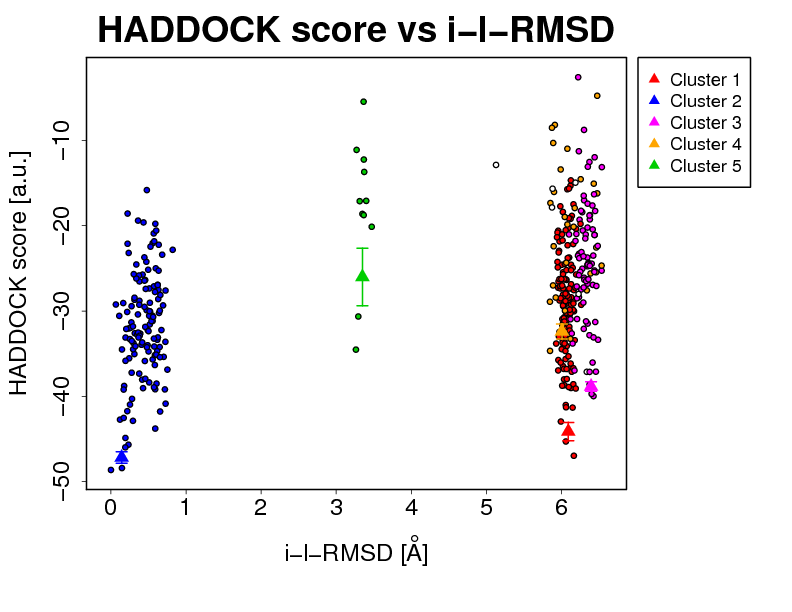
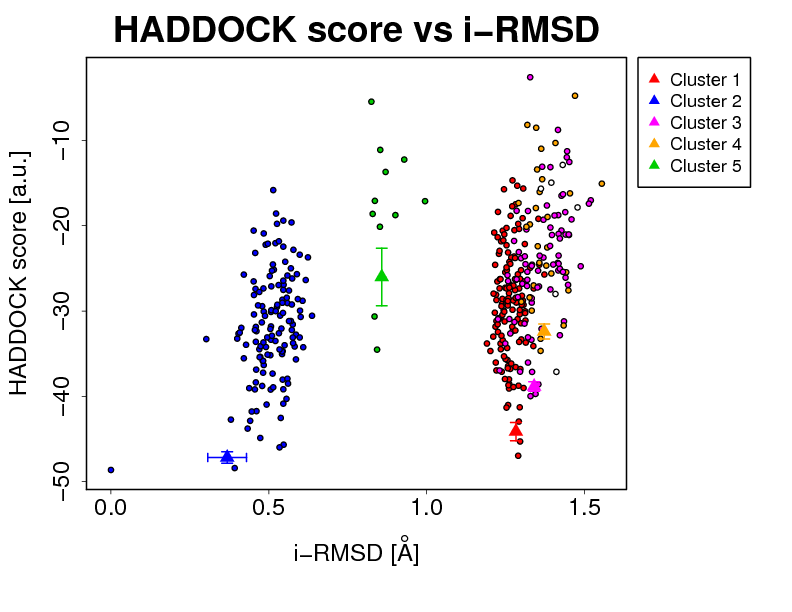
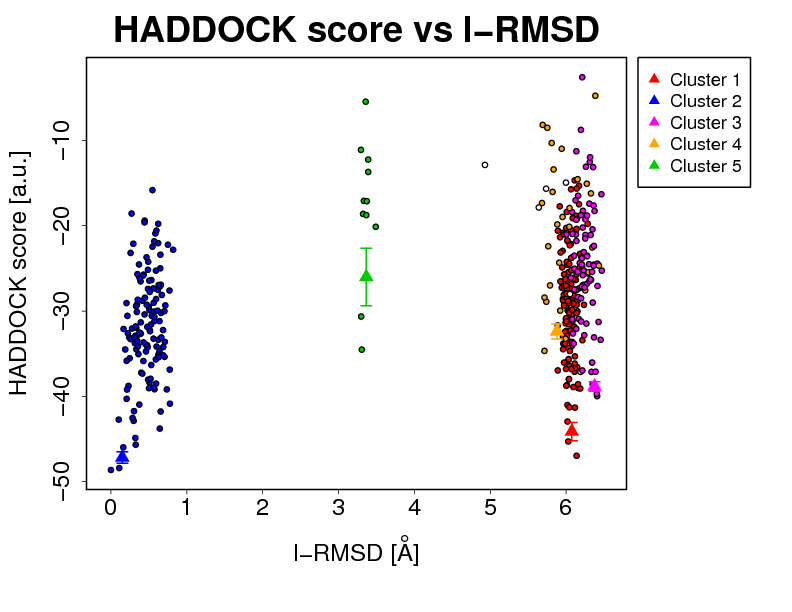


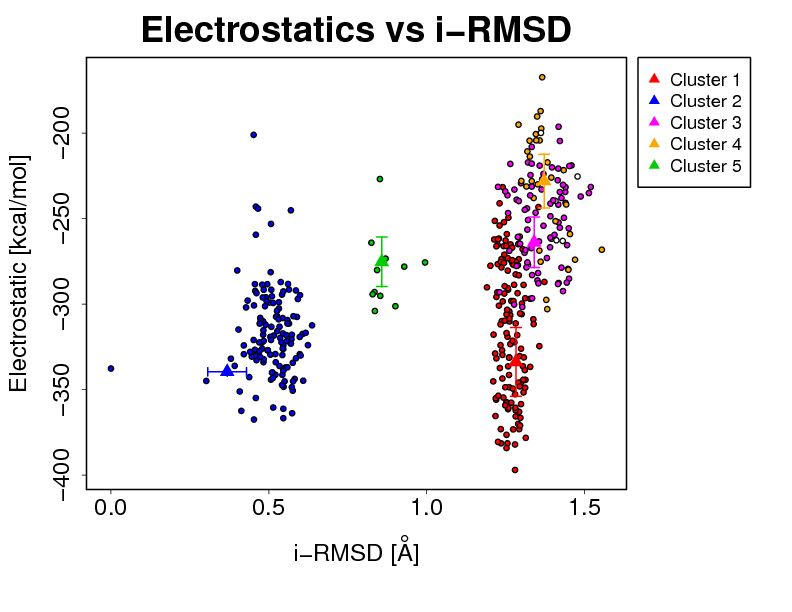
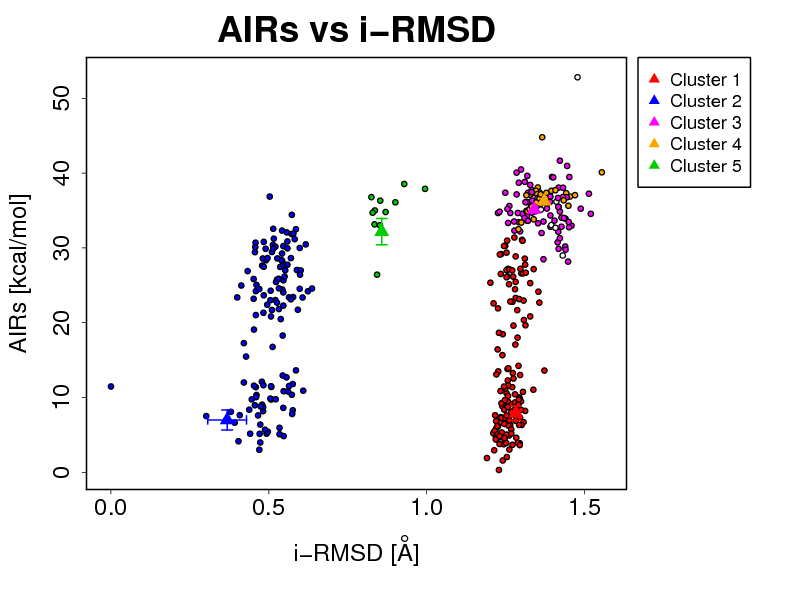
- Supplementary information:
- i-RMSD -> interface-RMSD calculated on the backbone (CA,C,N,O,P) atoms of all residues involved in intermolecular contact using a 10Å cutoff
l-RMSD -> ligand-RMSD calculated on the backbone atoms (CA,C,N,O,P) of all (N>1) molecules after fitting on the backbone atoms of the first (N=1) molecule
FCC -> Fraction of common contacts. The intermolecular contacts are defined based on the best HADDOCK model using a 5Å cutoff (see Rodrigues et al, Proteins 2012)
a.u. -> Arbitrary Units
The cluster averages and standard deviations are indicated by colored dots with associated error bars. The average values are calculated on the best 4 structures of each clusters (based on the HADDOCK score).